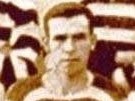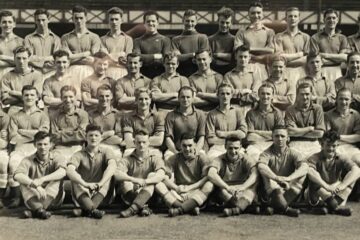 Born within the sight and sound of burning sparks and roaring bellows, William Black was the first football player to arrive at Goodison Park who had been born in the mist-covered islands of the Inner Hebrides, where his father, Duncan, had chosen to make a home for himself and his wife, Catherine.
Born within the sight and sound of burning sparks and roaring bellows, William Black was the first football player to arrive at Goodison Park who had been born in the mist-covered islands of the Inner Hebrides, where his father, Duncan, had chosen to make a home for himself and his wife, Catherine.
The couple had first met – and married – at Blackburn Street in the Plantation area of Govan (now part of Glasgow) where their first child, Duncan junior, was born. Shortly after this event, Duncan accepted the position of Village Blacksmith at Torosay on the Island of Mull and set up home at a location known as The Lochbury Croft and it was here that William – their fourth child – was born on 5 September 1882.
He spent the early part of his life on The Isle of Mull until the death of his father on 2 January 1889, which forced Catherine to go to live with her aunt, near to her birthplace at Tayvallich in the Knapdale region of Argyllshire. She spent several years here before moving back to Lanarkshire.
The Black family took up residence at Motherwell where Willie – now serving an apprenticeship at a local foundry – began playing juvenile football with the Enfield Star club. In the summer of 1902, he moved up to junior level when he signed for Dalziel Rovers who were members of the Lanarkshire League. During his time with the Motherwell-based club, he represented the League XI and was selected to play junior football for Scotland. The next season he moved up to senior level and joined the famous Glasgow amateurs, Queens Park.
The Hampden Park club were members of Scottish League Division One and Willie Black found himself pitted against the leading clubs in the land. On 24 January 1904, he took part in his first Scottish cup tie but his side were beaten 3-0 by Dundee at Dens Park. He helped Queens Park to complete the season in midtable and left them as the season came to an end.
On 21 April 1904, Willie Black signed for Celtic and made his debut in a 4-1 home win over Port Glasgow Athletic. He made another ten appearances as the Parkhead club and went on to win the Scottish League championship. On 29 May 1905 – following an approach by Mr Daniel Kirkwood – Willie Black left Celtic and signed professional forms with Everton in a deal which amounted to £400 and included team mate, James Hannan.
The Scot made his Football League debut on 16 September 1905 against reigning champions Newcastle United at Goodison Park as Everton were beaten by two goals to one. He then made regular appearances on both flanks of the half-back line and was included in the line-up for the local derby game against a Liverpool side who were challenging for the championship. The local journalist who viewed the occasion described the scene that greeted Willie Black as he stepped out on to the playing area:
The crush was so great that not only was the proper accommodation packed, but spectators encroached up on the playing area. Fully an hour before the kick-off, the capacity of the ground was tested. At 2:30, the dense and swaying crowd, at the Oakfield Road, broke down the railings and surged on to the field. A staff of Constables kept the spectators behind the touchlines, but shortly afterwards a similar incident occurred and a full avalanche of spectators poured on to the ground. All around the playing pitch, enthusiastic supporters of either side poured around the touchlines. Others climbed on the roofs of the stands while several partisans swarmed up the pillars supporting the stand and perched themselves in the forks of the ironwork. The ground is supposed to hold 28,000 people but 35,000 were present while thousands remained outside unable to gain entrance.
(Liverpool Courier 14 April 1906.)
Amid all the chaos, the game went ahead and Jack Taylor had given the visitors a half-time lead when a late penalty – converted by West – made the final score 1-1. Willie Black was almost certainly included in the Everton party when they left for London two weeks later to contest the FA Cup Final against Newcastle United at the Crystal Palace. However, he took no part in the game that saw Everton lift the trophy for the first time with a 1-0 victory. The party then had to spend the weekend sightseeing in the capital because the next Monday they were obliged to honour their rearranged Football League fixture away at Sheffield Wednesday.
They left from Marylebone Railway Station and arrived at Sheffield Victoria where two horse-drawn brakes were waiting to take them on to the home of their opponents in the district of Owlerton. Jack Taylor – who sat alongside the driver – was warmly applauded as he held the trophy aloft during the journey through the streets of the ‘steel town’.
Everton had made three changes to the cup-winning side when they took to the field at Hillsborough. Both first-choice full-backs were absent while Willie Black replaced Harry Makepeace in the half-back line. They lost the game by three goals to one.
The visitors then made a prompt departure for nearby Wadsley Bridge Railway Station because it had been arranged for an express train make an unscheduled halt in order to convey them quickly back to Liverpool. They were shocked to discover that, amidst all the excitement, the prized trophy had been left behind in the dressing room. The Wednesday club, however, saved the day by dispatching a member of staff after them, ‘post haste’, and the FA Cup was back with its new owners as they departed on their homeward journey.
Thousands of people – amongst them many local dignitaries – waited to greet the Everton party as they steamed into Liverpool Central Station where the trophy was displayed amid scenes of great excitement. Willie Black – no doubt impressed by the spectacle – next season agreed to re-join Everton for a wage of £4 per week.
The Scotsman failed to gain a regular place in the club’s First XI, but was made captain of Second XI, who played their matches in the Lancashire Combination. During the course of the season, he made just seven Football League appearances and was offered the same terms for the following season. However, he declined the offer and returned to play football in his native Scotland.
Willie Black first played for Kilmarnock and then made one appearance for Dumbarton – on 7 October 1907 – and helped them to a win over Albion Rovers. He then carried his football boots to several different parts of the country. Black again played for Kilmarnock, then represented Hamilton Academical before moving on to Ayr Parkhouse. The West Coast club were in the process of amalgamating with their main rivals Ayr FC so, eventually, he turned out in the colours Ayr United. Willie Black then returned to junior football at nearby Annbank before ending his career with the Thornhill club in Dumfries.
He had found employment as a brass moulder and spent the rest of his working days at this occupation. On 30 December 1912, Willie Black married Isabella Murray at her home at 61 Almada Street in Hamilton. The couple then set up home at Kirkland Street in Motherwell where they raised two children. William Black passed away there on 7 February 1960. He was buried at the local Airbles Road Cemetery.



